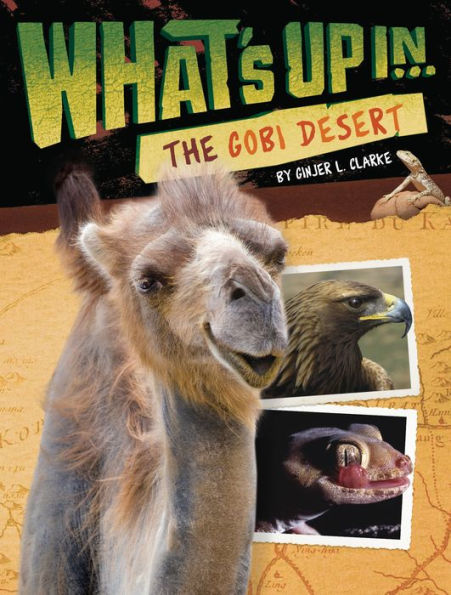

Related collections and offers
Overview
Gobi means "waterless place" - the perfect name for a desert! The Gobi covers parts of northern China and southern Mongolia. But contrary to the typical desert image, only 5% of the Gobi has sand dunes! It is also very cold, with an average temperature of only 37 degrees Fahrenheit for the entire year. Explore the expanse of the Gobi Desert with this fascinating addition to the What's Up series, and discover the wild plants, animals, and people that call this habitat home.

Product Details
| ISBN-13: | 9780451534231 |
|---|---|
| Publisher: | Penguin Young Readers Group |
| Publication date: | 03/15/2016 |
| Series: | What's Up |
| Sold by: | Penguin Group |
| Format: | eBook |
| Pages: | 144 |
| File size: | 416 MB |
| Note: | This product may take a few minutes to download. |
| Age Range: | 8 - 12 Years |
About the Author
Read an Excerpt
Introduction
Ah-rooo! Do you hear that? A wolf howls in the distance, and then another one answers. If you lean down and listen closely, you can also hear small creatures scampering softly in the sand. You can see their tiny footprints as the moon lights your way in the dark night.
Look up! Millions of stars fill the vast night sky. You can see them all, because there are no lights anywhere to block your view. There are no other people nearby, either, but there is still plenty of action around you.
Although it is freezing at night, many animals hunt quietly in the dark to avoid the scorching daytime temperatures. After the sun rises, everything changes. Herds of noisy, stinky camels roam the desert. Hundreds of antelopes, gazelles, and ibex clamber over the rocks. Smaller animals burrow underground to escape the intense heat that rises off the sand in shimmering waves.
What’s up with this place? It’s the Gobi Desert! This central Asian desert is different from other deserts in many ways. And it is one of the wildest habitats on our planet.
Chapter One: What Is the Gobi Desert?
Visiting the Gobi Desert is almost like going to Mars. Some parts of this desert are rocky, dry, and barren, seemingly without life. The extreme temperatures and lack of water make it hard to believe that anything—or anyone—could survive there. But they do. In fact, many of the animals that live there don’t live anywhere else on Earth. The Gobi Desert is the last safe place for some endangered animals that have been pushed out of other habitats by people.
Where is this place? The country of Mongolia is in the center of Asia, sandwiched between Russia and China. The Gobi Desert is located in the southern part of Mongolia and the far northern part of China. The Great Wall of China lies just to the south of the desert.
The Gobi is the largest desert in Asia and the fifth largest in the world. It is roughly oval-shaped and covers about 500,000 square miles—that’s twice the size of Texas! Its remote location and challenging climate have made it the least populated habitat on the planet other than the polar ice caps.
Deserts cover about 5 percent of the Earth’s surface. A desert is an area that receives less than ten inches of rain per year. The Gobi gets only about two inches of rain in the west and eight inches of rain in the northeast. Why is the Gobi so dry? It loses more moisture through evaporation than it receives from precipitation. That means it doesn’t get enough rainfall to replace the moisture that is lost when the sun heats up the air and sucks out the water.
Lack of rainfall in the Gobi is caused by the rain shadow effect, when high mountains block rain from falling, which creates dry land. In this case, the Himalayan Mountains to the south of the Gobi block clouds carrying moisture from the Indian Ocean. The Gobi is also a long way from the Pacific Ocean to the east. Most rain clouds run out of moisture before they reach the Gobi. The northern part of the desert is the farthest place from a large body of water on the planet!
The word gobi means “waterless place” in the Mongolian language, but the Gobi is not completely without water. There are a few rivers in parts of the desert, but most flow only in summer, when the desert gets a little rainfall.
Most deserts are very hot, but because the Gobi is the northernmost desert, it can also be very cold. In winter the average temperature is –40º Fahrenheit. Some parts of the Gobi are covered in ice and snow that never melts. In summer the high temperature can go up to 120º Fahrenheit. Sometimes the temperature changes 50º between daytime and nighttime!
The drastic weather changes create fierce winds that blow up to thirty miles per hour. Whoosh! The winds sweep across the desert and carry huge amounts of sand with them. Sandstorms can be so massive that they temporarily block out the sun, making day look like night.
Sometimes dust devils, which are similar to tornadoes, also develop. Swirl! Whirl! These intense storms start quickly and cause a lot of damage. They can carry away animals, destroy tents, and even strip the paint off vehicles!
Most people imagine deserts with lots of sand, but the Gobi is only about 3 percent sand. The landscape is made up mostly of gravel plains, rocky areas, and even some snowcapped mountains. Does this seem like it would be gray and boring? It’s not! Rocks come in every size, shape, and color in the Gobi. The many colors are created by the effects of sun, sand, and wind on the rocks. And the colors change during the day as the light changes.
